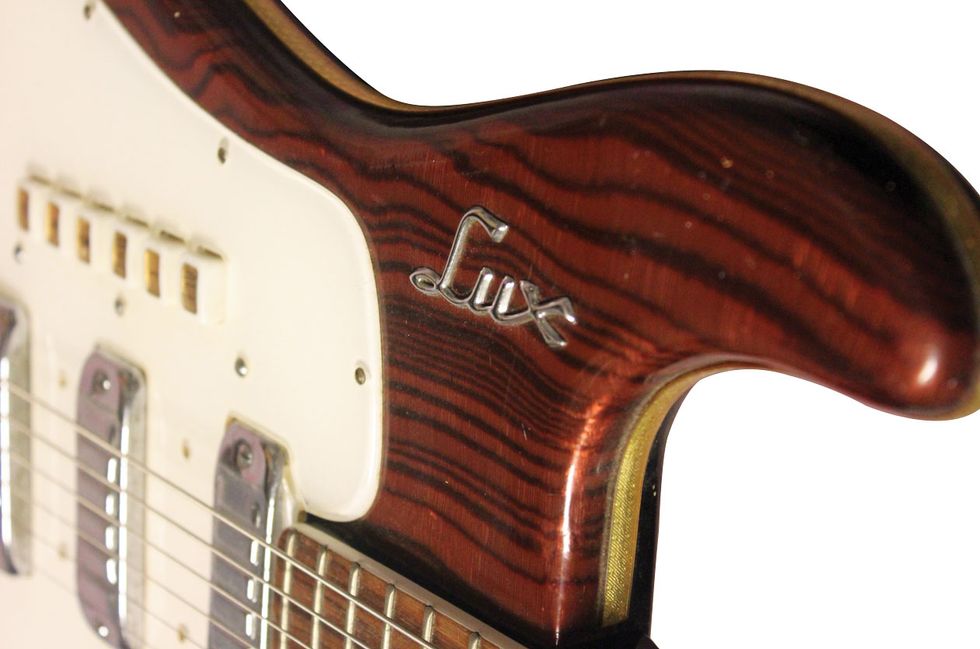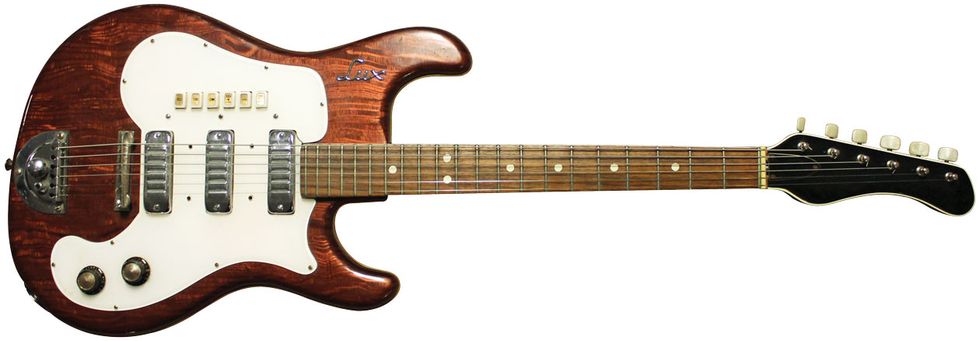In the northeastern U.S.—my stomping grounds—girls’ field hockey is an astoundingly popular sport. Over the past five years, I’ve trucked my daughter to high schools, parks, and tournament fields all around this end of the country. I really dig watching her play, but these family excursions also offer plenty of opportunities to scope out music stores, antique shops, and flea markets. Guitars are always on my brain—it’s like a virus.
Way before my family life began, I’d often venture out on what I called “guitar excursions.” These trips had me driving many miles in search of interesting guitars and gear, and I had some truly epic adventures. Like the time I drove six hours with a hurricane on my tail to buy a Sekova Grecian. Or the time I found three old Univox Super-Fuzz pedals, still in the box, at a flea market mixed among old tractor parts.
On one of my recent field hockey trips, I came upon this Italian beauty (Photo 1) at a remote antique store that the owner would only open if you went down the street to his home and knocked on his door. Whenever I see faux wood finishes, pearloid appointments, and accordion push-buttons, I’m instantly smitten. Old Italian electric guitars are certainly not as plentiful as Japanese offerings, but there are many oddball Italian guitars that capture the flair and esthetic sense of the time. Luckily for us here in the States, Italian guitars were imported with regularity, albeit in modest numbers.
This old Lux-branded guitar has plastic “wood grain” covering a solid wood core, and it sports a garish strip of gold binding that just rules (Photo 2). The Lux’s single-coils are rather hot and responsive. Thankfully, all the push-buttons work and offer varying degrees of coolness. The sonic spectrum runs from super thin at the bridge to massively thick when all the pickups are selected. Heck, even the tremolo works well. Because it doesn’t carry the hallmarks of any particular Italian manufacturer, the origins of this Lux guitar remain a mystery.
I confess: When I stumbled across this one, I almost passed on buying it. Believe it or not, in all the hundreds of guitars I’ve come across, this Lux had the worst neck bow I’d ever seen. Seriously folks, it looked like a banana . . . like it had been tuned above pitch with heavy flatwound strings for over 50 years. That kind of bad.
Buying vintage guitars carries some risk because those that are hitting the 50-year mark and beyond are prone to quite a few similar problems. In particular, when Italian accordion makers started to dabble in electric guitars, most of the factories had only a rudimentary knowledge of truss rods. (Of course, this was a problem with guitar manufacturers all over the world in this era.)

This Lux’s truss rod was so under-spec’d that even if you were to completely tighten it, you’d barely affect the neck. Many a truss rod has been broken by some unsuspecting oaf trying to correct a severely bowed neck. (All you oafs can join me with a thumbs-up. We know who we are.) Luckily, I haven’t yet seen a neck that refused to respond to a heat treatment, and I have to thank my good friend and tech Scott Freilich for correcting this insane bow.
Whenever you buy an old guitar like this, you have to anticipate the need for some fretwork and neck wrangling, so it’s crucial to know a good tech to help you resurrect these beauties. But bringing them back to life is worth the investment—you just have to find someone who understands the quirks of old electric guitars. And if you’re going to dive into vintage guitars, you’re going to run into quirks! In an age where so many guitars feel generic, forgotten gems like this Lux deserve a little love and attention to get them straightened out … with just a bit of curve, like a good field hockey stick.
Watch the video demo:
















